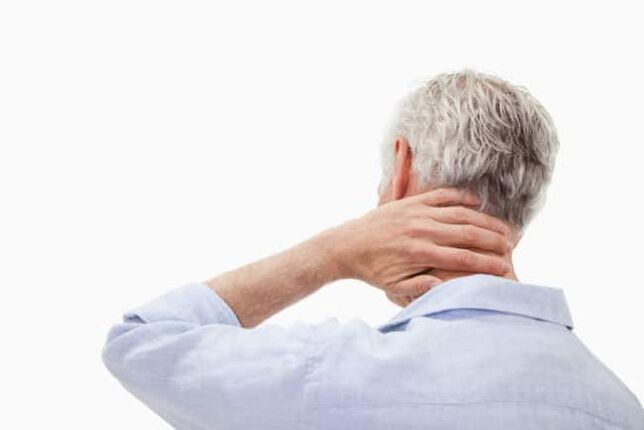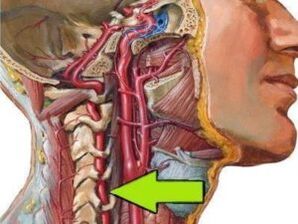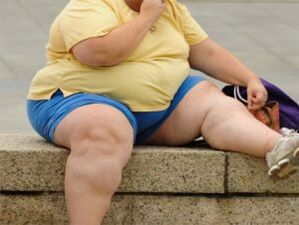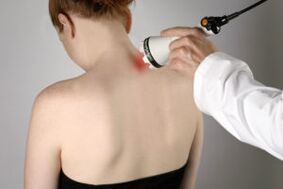Cervical osteochondrosis is considered one of the most common and painful processes in all pathological processes that affect different parts of the spine.The disease causes many complications, mainly because it affects the spinal cord and can also have a negative impact on brain function.

What is cervical osteochondrosis?
The word cervical osteochondrosis in medical practice means a progenitative disease that affects a particular spine.This pathological process is characterized by degenerative failure processes in the intervertebral disc tissue, which are shock absorbers of the cervical spine.The degenerative nutritional changes in intervertebral discs are due to their deletion and deformation.Therefore, the distance between the vertebrae is reduced, and the following consequences occur:
- The spinal canal in certain areas of the spine becomes narrower.
- Through the vertebral artery - the large blood vessel that provides the brain with blood supply.As a result, the supply of the brain deteriorates and blood circulation in the cervical spinal cord is disturbed.
- The intervertebral disc can be deformed and flat.This results in inhibiting various parts of the spinal cord and nerves, more often squeezing the nerve roots.
All these problems not only threaten the invasion of blood circulation in the brain, the neck, headache and other painful sensations.The development of osteochondrosis in the cervical area has problems with neurological properties, deterioration of the central nervous system, and damage to brain tissue.According to the International Classification of Diseases, several separate regulations are assigned to osteochondrosis in the cervical area.The disease code for ICB 10 depends on the age of the disease: Diagnosed with the disease:

- M02-Discal Malnutrition during puberty.
- M42.12 is a malnutrition process in adult necks.
Many factors depend on the patient's age and the degree of development of the pathological process, such as consequences, complications, symptoms, and of course the principles of treatment.
reason
Knowing the causes of osteochondrosis development in the cervical area can play a decisive role in the diagnosis process and determine the principles of fighting the disease.However, before listing the causes, it is worth mentioning that doctors distinguish two factors that lead to the development of this pathological process:
- Pathology - Under the influence of adverse external factors, the destruction of intervertebral discs and other vertebrates is involved in the pathological process with nearby tissues, blood vessels and nerve bundles.The more difficult these factors and other pathology, the faster the disease develops.
- Physiology - Based on pathology development, mainly age-related changes.We are talking about the natural aging of the spine, salt and other medium cartilage tissues.
If we list more specific causes of cervical osteochondrosis, then the following are:
- Violating the in vivo metabolic process and certain stages of obesity.
- Hypoemia is a phenomenon characterized by mobility limitation.This is not only related to injury or illness, but can also include a sedentary lifestyle and sitting work.
- The pathology of the cardiovascular system leads to impaired blood circulation in the brain, stress changes and other factors.
- Incorrect postures, these are all forms of scoliosis, rheumatism and even flat feet.
- Inject cervical vertebrae.In this case, we are talking about sprains, strikes, bruises.Studies on other spinal developments in other spinal developments may affect the development of cervical osteochondral disease.
- Due to the types of human activities, excessive physical fatigue in the cervical area caused by enhanced exercise or severe physical difficulties.
- A sedentary lifestyle is also dangerous, and if you sit in incorrect or uncomfortable furniture, the continuous tension of the cervical spine and the entire spine is also dangerous.
- Cervical hernia and various related diseases.
- Hold the head for a long time in uncomfortable or unnatural positions.In this case, not only muscle overprocessing occurs, but the spine also curves in the cervical region.
- Doctors believe that continuous stress and nerve overvoltage are very common causes.
- One of the reasons is also considered to be congenital abnormalities in the spinal structure.

What are the dangers to health?
As mentioned earlier, in the cervical spine, not only the spinal cord and various nerve branches are located, but also the spinal arteries of the occipital bone, cerebellum and myeloid brain.As the cervical osteocartilage develops, nearby tissues are inflamed.In addition, pathology development has the potential to squeeze nerve roots and spread blood vessels, with the consequences as follows:
- Osteocartilage degeneration is accompanied by deformation of the spine, which results in narrowing in certain areas.This may cause spinal cord and nerve branches to squeeze, which is expected to have serious neurological problems.In severe cases, a person can feel pain, even if the control over various parts of the body may be lost (mainly on the hands or face).
- As mentioned earlier, squeezing blood vessels in the neck is accompanied by blood circulation in the occipital area of the brain.Meanwhile, the brain stops receiving the amount of oxygen and nutrients required, and oxygen hunger begins.Using circulatory diseases, there is a real risk of ischemic stroke and various neuropathological conditions.
Syndrome
The main syndromes are:
- Spine.
- Vertebral artery.
- Koreshka.
- heart.
It is important to know that each of these symptoms is accompanied by a different nature of painful sensation and many adverse clinical signs.One person will feel dizzy, there is noise in his ears, and more.

Vertebral syndrome
It talks about the direct connection between the cervical area and bone and cartilage tissue.Symptoms in this type of pathology are also related to the lesions in the above tissues:
- The movement of the neck is partially limited.
- Head movement is accompanied by neck pain.
- X-rays show morphological changes in tissues (inside vertebrae and vertebrae).
It is worth noting that vertebrae syndrome is always accompanied by these three clinical signs.If at least 1 is not present, the diagnosis will be completely different.
Rook syndrome
This occurs when the roots of the spinal cord are damaged.At the same time, the nerve conductivity is disturbed, and a person will feel pain or lose sensitivity to various parts of the body or even paralyzed.This symptom is distinguished based on which of the 8 radiation couples has conductivity interference:
- 1 pair - Numbness or pain in the back of the head;
- 3 pairs - Violation of chewing reflexes, numbness of tongue and unpleasant sensations behind the ears;
- 4 pairs - Pain in the clavicle, violating the swallowing reflex;
- 5 pairs - Violation of shoulder straps, accompanied by manual exercise problems;
- 6 pairs - The patient began to feel pain and numbness in the forearm and shoulder blade bones.
- 7 pairs - numbness of hands and fingers (usually index and middle);
- 8 pairs - Similar to the problem of past projects, but feeling numb on the ring finger and pinky finger.
Heart syndrome
Although the pathological process is still in the cervical spine, the syndrome still has all the signs of heart disease.The clinical situation is as follows:
- Quick pulse.
- Pain in the sternum area.
- Shortness of breath, weakness, drowsiness, and decreased performance.
Signs and symptoms of cervical osteochondrosis
For seeking a doctor in time, it is necessary to have a clear understanding of the signs of cervical bone cartilage.In some cases, this knowledge allows you to seek help in the initial stages of the disease, when it is easier to treat.Usually, the symptoms of cervical osteochondrosis are as follows:

- Pain in osteochondrosis always exists, only with different intensity and frequency.Pain is the first clinical sign.Their strength depends on the stage of disease progression, and in nature, they are stupid or squeezed.The painful sensation is mainly found in the neck of the occipital area, but may also radiate to the temporal area, shoulder straps, and hands.
- In most cases, there is a manifestation of vestibular device lesions.We are talking about frequent causeless dizziness, nausea, uneven movement coordination, imbalanced gait, and space loss.
- One of the most common clinical signs is stiffness of the neck muscles and stiffness of movement.It is difficult for a person to turn his head, lower and shake his head, and the movements will react with painful pain.
- Many patients notice the chicken skin ump "passing through the scalp" or feel the characteristic tingling sensation.
- There is muscle weakness and numbness in the area of the hand.
- There are usually psychological manifestations, expressed as sharp changes in depression, lethargy, mood, temper, or irritability.
- Dizziness is aggravated due to impaired blood circulation and damage to brain tissue, and the noise in the ears is similar to rustling, pulsing, and ringing.
- Most patients notice visual impairment and pain in the eye, especially when trying to cut the eye to a great extent, left, right, up or down.
Sometimes the degree of development of the pathological process can be determined by symptoms.However, for a complete diagnosis, this is still not enough and many diagnostic measures are required.
Diagnostic method
To determine the localization and stage of disease progression, cervical osteochondral disease must be diagnosed.For a comprehensive diagnosis, this diagnostic method is needed:
- X -Ray - The main method that allows you to determine the degree of spinal deformation and position.
- You can use computed tomography to diagnose pathological changes in the vertebrae and disc more accurately.
- MRI (Magnetization Imaging) - The wheels and vertebrae can be examined in detail to determine the size of hernia, protrusions, and other lesions.
- Multifluidic surgery - At the same time, examination becomes the place to find the squeezed artery and evaluate the degree of circulatory disease.
Treatment method
Treatment of cervical osteochondrosis always means a comprehensive approach.The principle of treatment depends on the quality of factors, such as the patient's age, the stage of the disease development, the brightness of the clinical situation, etc.However, in this case, you can’t do without a doctor, first you can consult a therapist, then consult you, and then direct you to a vertebralist.As for the comprehensive approach: osteochondria with cervical osteochondria, using medications, physical therapy, massage, exercise therapy and other osteochondria that should be discussed in more detail.
Drug treatment
The basis of treatment for cervical osteochondrosis is drug treatment, involving the use of tablets, drugs and medications in this group:
- Anesthetics - painkillers and impurities.The former directly directs the nervous center, thus preventing the pain.The latter allows you to relieve cramps in your neck muscles, build blood flow and suppress pain.
- NSAIDS-Nonsteroid anti-inflammatory drugs are necessary to reduce the inflammatory process, most of which also eliminate pain.Typically, these drugs are used in the form of gels and these ointments are rubbed to the affected area.
- musorelaxant is another way to remove muscle spasms in the cervical area.
- Cartilage protectants are mandatory at certain stages of CHOP osteochondrosis, as they contribute to the recovery of bone tissue.
- B vitamins - normalizes the metabolic process of neural tissue, improves the conductivity of nerve impulses, and contributes to the work of the central nervous system.
Remember that treatment is only performed under the supervision of a doctor, and that doctor should appoint each medication and determine its intake and duration of the dose.
physiotherapy
Treatment of cervical osteochondrosis using certain physical therapy techniques will be more effective:

- Electrophoresis.
- Laser therapy.
- ultrasound.
- massage.
Massage therapy must be performed by experienced health workers with treatment at least 10 sessions.Massage in the cervical area helps normalize blood circulation, restore elasticity, muscle tone, relieve pain, etc.
Manual therapy
Manual therapy is based on the principle of restoring motor function and mobility between vertebrae.Initially, the manipulation was in a relaxed massage, and the doctor then attached more and more strength to act on the pressure and neck-turning vertebrae.
The use of a Kuznetsov applicator is one of the treatments for spinal diseases, including osteocartilage.Adaptations normalize the metabolic process, reduce pain, increase muscle tone, improve blood circulation, increase the conductivity of nerve tissue, etc., to prevent osteochondrosis, which is useful for swimming and hanging for 2-3 minutes a day.


























































































